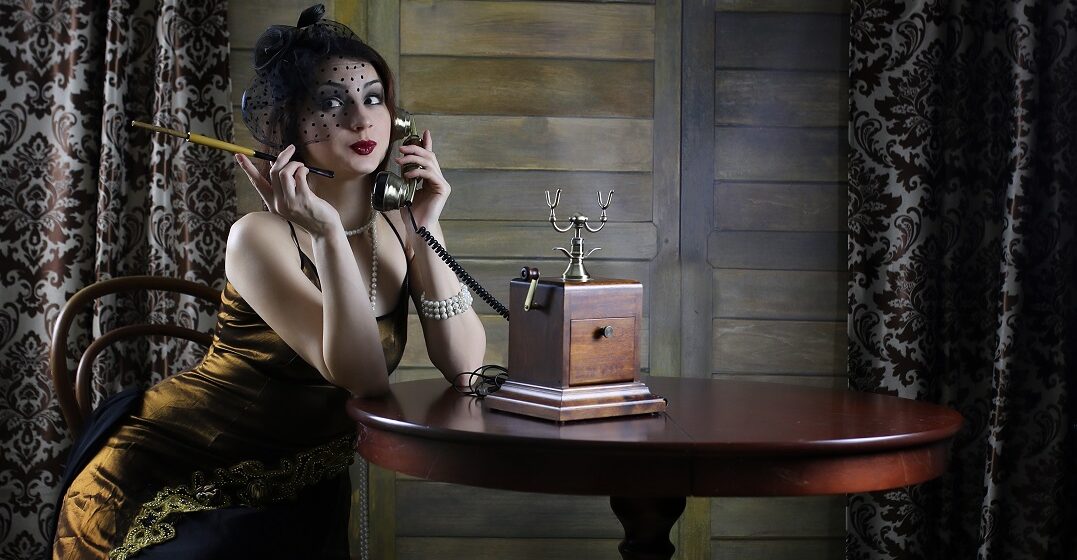Updated on January 3, 2024

The 13 very best 1920s slang terms

The roaring twenties were a time of artistic and cultural experimentation. Between the catastrophes of the First World War and the Wall Street crash came a time of industrial expansion and huge change. It was the height of the jazz age, the world of the Great Gatsby, with flappers dancing the Charleston and Lindy Hop in smoke-filled speakeasies alongside gangsters in pinstripe suits – or so we like to remember it.
The wild and roaring twenties were a time of such cultural furor that it’s no wonder a wave of new vocabulary was born with it. Here are some of our favorite examples of roaring 20s English language slang terms, some that have stayed with us since then (and some that we really ought to bring back).
This term was given to young women in the 1920s who typically wore bobbed haircuts and short skirts, enjoyed jazz music, smoked cigarettes, and otherwise rebelled against the cultural norms of “acceptable behavior” for a woman of the time. Famous actresses and socialites like Marlene Dietrich, Clara Bow or Joan Crawford typify the flapper spirit of glamor and scandal.
If something is the ‘cat’s pajamas’, or alternatively the ‘cat’s whiskers’, it is cool, fashionable, high quality or otherwise stupendous. This wacky phrase that has stuck with us even today captures something of the eccentricity of the Bohemian 1920s subculture of the US east-coast where the phrase is believed to have originated.
The ‘bee’s knees’ means more or less the same as the cat’s pajamas and probably came into use in the same quirky scenes. Not only that, but it’s also given name to a classic cocktail.
Spiffy is a great way to describe someone looking stylish, smart or elegant.
An evocative term for a cigarette, typically the cheap kind that really did leave people gasping.
A person who never drinks alcohol. While the term had been used long before the roaring twenties, the phrase came into common use during the prohibition era, when the USA instituted a nationwide ban on the consumption and production of alcoholic beverages.
A bar or speakeasy. Even in the midst of the American prohibition, these illegal juice joints provided thirsty patrons with all the “giggle juice” (hard liquor) they could handle.
A drunkard who likely spends too much time in the local juice joint.
Putting on your glad rags was a way to say dressing up in your most fancy and fashionable clothes.
This is an earnest old phrase to express that someone is suffering the heartache of an unrequited crush, infatuation or love. While this one is only occasionally used today, it is ripe for a revival amongst the hopeless romantics of today.
Newsies were newspaper vendors, generally adolescent boys who would sell their papers on the streets, typically selling for one major paper for a pittance wage. These newspaper hawkers are probably best remembered nowadays for the 1992 musical movie Newsies, starring a young Christian Bale.
Now we’re into the classic 1920s gangster slang phrases. Cement shoes or the Chicago overcoat referred to a method of hiding a body or murdering someone by weighing down the victim with concrete and dropping them into a body of water. While it’s not clear if this was actually a practice amongst gangsters in the 1920s, it certainly is a popular trope of gangster movies set in the time. The Chicago overcoat might also refer to a coffin or to the practice of burying victims underneath concrete buildings or roads. Chicago is well remembered as the city where organized crime flourished in the 1920s. Fortunately, the term has disappeared from common parlance these days.
“You won’t find him. He’s wearing a Chicago overcoat/cement shoes now.”
If you know your gangster movies, you can probably understand that when the mob boss suggests “taking someone for a ride” it implies anything but an innocent evening drive. The poor passenger is being driven off to a convenient spot to be bumped off (killed).
“He didn’t pay me what he owes me. I think we’ll have to take him for a ride, don’t you?”
Whether you’re a history buff or a classic gangster film enthusiast, we hope you enjoyed this dive into the slang phrases of the 1920s. Like glitzy flapper dresses and bobbed hair, we hope that some of these quirky old phrases of roaring twenties slang can make a comeback one hundred years later. But let’s leave the gangster talk to the movies.